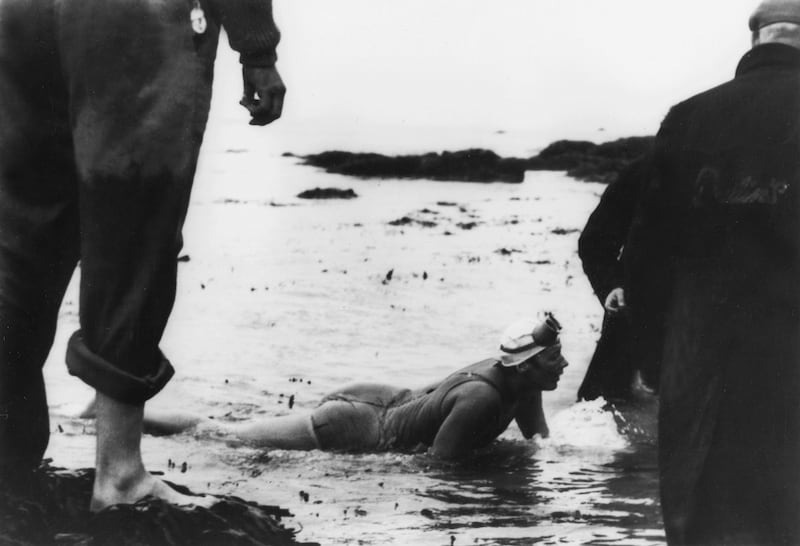The day the Nazis invaded Denmark in April, 1940, as part of Operation Weserübung Sud, Greta Andersen looked up in the sky over Copenhagen and saw an aeroplane emblazoned with a swastika dropping pamphlets that read, “You don’t have a king any more!”
Fearing what the occupying force was capable of, the then-12-year-old’s parents took immediate action. They chopped her blonde tresses short, raided the wardrobe of her older brother (by then part of the Danish resistance), and dressed her like a boy for the duration of the war. She hated the feel of the clothes but understood the logic.
“I can still see them walking out with all the belongings they stole,” said Andersen of the day the interlopers finally departed. “All the bags and all the clothes, and we were yelling at them when they walked out. The damned Germans.”
Near the end of the occupation her father, a former Olympic gymnast, had a notion to teach his daughter how to swim. Not an idea she was crazy about. Six months passed between her first unimpressed visit to the local pool and her second, and even then, the teenager drew mocking glances for bobbing around in an inner tube for fear of drowning. Soon, however, she discovered the lung capacity to swim 50m without drawing breath and, within four years, the reluctant swimmer stood atop the podium at the 1948 Olympics after winning gold in the 100m freestyle.
READ MORE
That meteoric rise prefaced a career in marathon open-water competition, a lucrative, box-office sport in the mid-20th century. Having emigrated to the US, she set 18 world records, achieved several landmark swims, and secured umpteen victories over male rivals.
Following her death at the age of 95 in California last month, the New York Times and other outlets described her in their obituaries as the greatest female swimmer in history. Nobody quibbled with the assessment because there is extant Pathe newsreel footage of her entitled, simply, “Greta the Great”.
Hers was a very singular life aquatic. She took home 1,000 guineas for winning the 1958 Billy Butlin Cross English Channel race, clocking the 22 miles in 11 hours on a day when conditions were so unforgiving no other woman and just four men from a field of 30 managed to complete the course. Her then husband John Sonnichsen, a high school football coach, rode alongside her in a launch throughout, playing rock’n’roll records on a portable phonograph to keep her spirits up. The kind of detail that hints at the richness of the sporting life she led.

In the 50-mile race across Lake Michigan from Chicago to Kenosha, Wisconsin another year, she won $25,000 and finished 10 miles ahead of the second-place swimmer. A man. She was the first person to complete the two-way crossing of the Santa Catalina Channel, just south of Los Angeles. A mere 44 miles. Even the occasions when nature defeated her were kind of epic. During an abortive attempt to swim the Molokai Channel in Hawaii, some of it inside a mobile cage to protect her from preying sharks, she spent 22 hours in the water, battling 10-foot swells, before being lifted out on a stretcher.
“Every few minutes I would look for Makapau lighthouse,” said Andersen. “Each time it seemed to get farther away. Then everything exploded in a confusion of stars, waves, lights and squeaking porpoises, and the next thing I clearly remember was being taken to hospital. I finally know how it is to fail in life. Maybe this failure has a grander purpose in my life that I cannot foresee yet. I hope so.”
She had known failure in swimming before, albeit in even more dramatic circumstances. Following her gold in the 100m freestyle in 1948, Andersen was favoured to win the 400m freestyle too. When she told the Danish team physician that her period was due the same day as her heat he wanted to give her an injection to slow down the onset of her cycle. Figuring the doctor knew best, she took the shot and felt fine until she started racing.
By that point in her life, she’d enjoyed a second career as a renowned and innovative swimming coach in California where she wasn’t above making headlines for her strong opinions
“Then I felt like paralysed in my legs, my stomach,” she said. “I just blacked out. I don’t remember. I was sinking. I was going underwater.”
Another competitor had to dive down to rescue her from the bottom of the Empire Pool at Wembley. Although she recovered to swim the 4x100m freestyle relay later that week, the coach didn’t trust her with the final leg of that race and, half a century later, she still spoke in interviews about his erroneous decision costing Denmark gold instead of silver. By that point in her life, she’d enjoyed a second career as a renowned and innovative swimming coach in California where she wasn’t above making headlines for her strong opinions.
“You see so many women in terrible shape,” said Andersen in 1967. “Their problems of home and family life are too much for many of them to handle. They have nothing to look forward to. I think very strongly that the reason so many American women are so nervous, so tense and upset is that they just don’t get any physical exercise. Lifting children in and out of strollers just doesn’t do it.”
She is survived by Dr Andre Veress, her third husband, and a litany of achievements never to be matched.

















